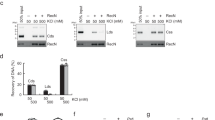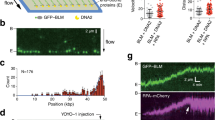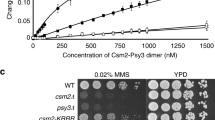Abstract
Homologous recombination has a crucial function in the repair of DNA double-strand breaks and in faithful chromosome segregation1,2,3. The mechanism of homologous recombination involves the search for homology and invasion of the ends of a broken DNA molecule into homologous duplex DNA to form a cross-stranded structure, a Holliday junction (HJ)4,5,6,7. A HJ is able to undergo branch migration along DNA, generating increasing or decreasing lengths of heteroduplex. In both prokaryotes and eukaryotes, the physical evidence for HJs, the key intermediate in homologous recombination, was provided by electron microscopy8. In bacteria there are specialized enzymes that promote branch migration of HJs7. However, in eukaryotes the identity of homologous recombination branch-migration protein(s) has remained elusive. Here we show that Rad54, a Swi2/Snf2 protein9, binds HJ-like structures with high specificity and promotes their bidirectional branch migration in an ATPase-dependent manner. The activity seemed to be conserved in human and yeast Rad54 orthologues. In vitro, Rad54 has been shown to stimulate DNA pairing of Rad51, a key homologous recombination protein10,11,12. However, genetic data indicate that Rad54 protein might also act at later stages of homologous recombination, after Rad51 (ref. 13). Novel DNA branch-migration activity is fully consistent with this late homologous recombination function of Rad54 protein.
This is a preview of subscription content, access via your institution
Access options
Subscribe to this journal
Receive 51 print issues and online access
$199.00 per year
only $3.90 per issue
Buy this article
- Purchase on Springer Link
- Instant access to full article PDF
Prices may be subject to local taxes which are calculated during checkout




Similar content being viewed by others
References
Krogh, B. O. & Symington, L. S. Recombination proteins in yeast. Annu. Rev. Genet. 38, 233–271 (2004)
Pα̂ques, F. & Haber, J. E. Multiple pathways of recombination induced by double-strand breaks in Saccharomyces cerevisiae. Microbiol. Mol. Biol. Rev. 63, 349–404 (1999)
Wyman, C., Ristic, D. & Kanaar, R. Homologous recombination-mediated double-strand break repair. DNA Repair (Amst.) 3, 827–833 (2004)
Holliday, R. A mechanism for gene conversion in fungi. Genet. Res. 5, 282–304 (1964)
Sung, P., Krejci, L., Van Komen, S. & Sehorn, M. G. Rad51 recombinase and recombination mediators. J. Biol. Chem. 278, 42729–42732 (2003)
Bianco, P. R., Tracy, R. B. & Kowalczykowski, S. C. DNA strand exchange proteins: a biochemical and physical comparison. Front. Biosci. 3, D570–D603 (1998)
Liu, Y. & West, S. C. Happy Hollidays: 40th anniversary of the Holliday junction. Nature Rev. Mol. Cell Biol. 5, 937–944 (2004)
Dressler, D. & Potter, H. Molecular mechanisms in genetic recombination. Annu. Rev. Biochem. 51, 727–761 (1982)
Thoma, N. H. et al. Structure of the SWI2/SNF2 chromatin-remodeling domain of eukaryotic Rad54. Nature Struct. Mol. Biol. 12, 350–356 (2005)
Petukhova, G., Stratton, S. & Sung, P. Catalysis of homologous DNA pairing by yeast Rad51 and Rad54 proteins. Nature 393, 91–94 (1998)
Mazin, A. V., Bornarth, C. J., Solinger, J. A., Heyer, W. D. & Kowalczykowski, S. C. Rad54 protein is targeted to pairing loci by the Rad51 nucleoprotein filament. Mol. Cell 6, 583–592 (2000)
Mazina, O. M. & Mazin, A. V. Human Rad54 protein stimulates DNA strand exchange activity of hRad51 protein in the presence of Ca2+. J. Biol. Chem. 279, 52042–52051 (2004)
Kim, P. M., Paffett, K. S., Solinger, J. A., Heyer, W. D. & Nickoloff, J. A. Spontaneous and double-strand break-induced recombination, and gene conversion tract lengths, are differentially affected by overexpression of wild-type or ATPase-defective yeast Rad54. Nucleic Acids Res. 30, 2727–2735 (2002)
Essers, J. et al. Disruption of mouse RAD54 reduces ionizing radiation resistance and homologous recombination. Cell 89, 195–204 (1997)
Suslova, N. G. & Zakharov, I. A. Genetic control of radiosensitivity in yeast, VII. Identification of the genes determining the sensitivity to X-rays. Genetika 6, 158–169 (1970)
Ristic, D., Wyman, C., Paulusma, C. & Kanaar, R. The architecture of the human Rad54–DNA complex provides evidence for protein translocation along DNA. Proc. Natl Acad. Sci. USA 98, 8454–8460 (2001)
Jaskelioff, M., Van Komen, S., Krebs, J. E., Sung, P. & Peterson, C. L. Rad54p is a chromatin remodeling enzyme required for heteroduplex DNA joint formation with chromatin. J. Biol. Chem. 278, 9212–9218 (2003)
Parsons, C. A., Tsaneva, I., Lloyd, R. G. & West, S. C. Interaction of Escherichia coli RuvA and RuvB proteins with synthetic Holliday junctions. Proc. Natl Acad. Sci. USA 89, 5452–5456 (1992)
Swagemakers, S. M., Essers, J., de Wit, J., Hoeijmakers, J. H. & Kanaar, R. The human RAD54 recombinational DNA repair protein is a double-stranded DNA-dependent ATPase. J. Biol. Chem. 273, 28292–28297 (1998)
Panyutin, I. G. & Hsieh, P. Formation of a single base mismatch impedes spontaneous DNA branch migration. J. Mol. Biol. 230, 413–424 (1993)
Tsaneva, I. R., Muller, B. & West, S. C. ATP-dependent branch migration of Holliday junctions promoted by the RuvA and RuvB proteins of E. coli. Cell 69, 1171–1180 (1992)
West, S. C. Processing of recombination intermediates by the RuvABC proteins. Annu. Rev. Genet. 31, 213–244 (1997)
Eggleston, A. K., Mitchell, A. H. & West, S. C. In vitro reconstitution of the late steps of genetic recombination in E. coli. Cell 89, 607–617 (1997)
Lusser, A. & Kadonaga, J. T. Chromatin remodeling by ATP-dependent molecular machines. Bioessays 25, 1192–1200 (2003)
van Brabant, A. J. et al. Binding and melting of D-loops by the Bloom syndrome helicase. Biochemistry 39, 14617–14625 (2000)
Constantinou, A., Davies, A. A. & West, S. C. Branch migration and Holliday junction resolution catalyzed by activities from mammalian cells. Cell 104, 259–268 (2001)
Liu, Y., Masson, J. Y., Shah, R., O'Regan, P. & West, S. C. RAD51C is required for Holliday junction processing in mammalian cells. Science 303, 243–246 (2004)
Interthal, H. & Heyer, W. D. MUS81 encodes a novel helix–hairpin–helix protein involved in the response to UV- and methylation-induced DNA damage in Saccharomyces cerevisiae. Mol. Gen. Genet. 263, 812–827 (2000)
Shinohara, M. et al. Characterization of the roles of the Saccharomyces cerevisiae RAD54 gene and a homologue of RAD54, RDH54/TID1, in mitosis and meiosis. Genetics 147, 1545–1556 (1997)
Bugreev, D. V. & Mazin, A. V. Ca2+ activates human homologous recombination protein Rad51 by modulating its ATPase activity. Proc. Natl Acad. Sci. USA 101, 9988–9993 (2004)
Acknowledgements
We thank P. Sung and M. Wold for hRad51 and hRPA expression vectors; S. Kowalczykowski, M. Spies and A. Alexeev for RecA, yRad51 and yRad54; J. Kadonaga for ISWI; G. Schnitzler and N. Ulyanova for hSWI/SNF; M. Bouchard and A. Kuzminov for comments and discussion. This work was supported by an NIH grant to A.V.M.
Author information
Authors and Affiliations
Corresponding author
Ethics declarations
Competing interests
Reprints and permissions information is available at npg.nature.com/reprintsandpermissions. The authors declare no competing financial interests.
Supplementary information
Supplementary Notes
This file contains Supplementary Methods, Supplementary Figures 1–12, Supplementary Table 1 and four references. (PDF 1022 kb)
Rights and permissions
About this article
Cite this article
Bugreev, D., Mazina, O. & Mazin, A. Rad54 protein promotes branch migration of Holliday junctions. Nature 442, 590–593 (2006). https://doi.org/10.1038/nature04889
Received:
Accepted:
Published:
Issue Date:
DOI: https://doi.org/10.1038/nature04889
This article is cited by
-
Stimulation of homologous recombination in plants expressing heterologous recombinases
BMC Plant Biology (2020)
-
RAD54 N-terminal domain is a DNA sensor that couples ATP hydrolysis with branch migration of Holliday junctions
Nature Communications (2018)
-
BIME2, a novel gene required for interhomolog meiotic recombination in the protist model organism Tetrahymena
Chromosome Research (2017)
-
Irc3 is a mitochondrial DNA branch migration enzyme
Scientific Reports (2016)
-
Replication fork reversal in eukaryotes: from dead end to dynamic response
Nature Reviews Molecular Cell Biology (2015)
Comments
By submitting a comment you agree to abide by our Terms and Community Guidelines. If you find something abusive or that does not comply with our terms or guidelines please flag it as inappropriate.



